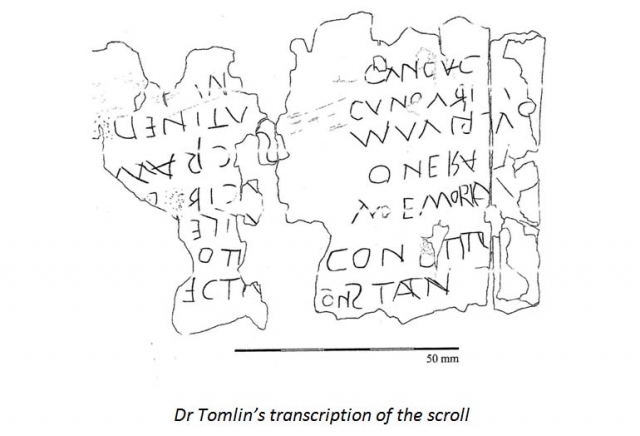Mysteries of East Farleigh's Roman 'curse scroll'

Kent Archaeological Society
The names of 14 people who may have lived in East Farleigh, Kent, nearly 2,000 years ago have been deciphered on a lead scroll found during Maidstone Area Archaeological Group's ‘dig' on the site of a Roman farmstead in a field off Lower Road.
Measuring 60 mm by 100 mm and only one millimetre thick, it is likely to be a ‘curse tablet'.
Used by the Romans to cast spells on people accused of theft and other misdeeds, the tablets were rolled up to conceal their inscriptions and then hidden in places considered to be close to the underworld, such as graves, springs or wells.
The Romans were the first inhabitants of England who could read and write. Therefore any personal names inscribed on their scrolls and other surviving artefacts are likely to be the earliest written records of inhabitants of the locality in which they are found.
The East Farleigh scroll bears in capital letters the Latin names SACRATUS, CONSTITUT[US], CONSTAN[...] and MEMORIA[NUS], the Celtic names [ATR]ECTUS and ATIDENUS, and eight others which are incomplete.
Funded by a Kent Archaeological Society grant, Dana Goodburn-Brown of Sittingbourne-based Conservation Science Investigations (CSI) is conserving the scroll and seeking ways to read its inscriptions.
‘It's very fragile,' said Dana, ‘ and as we were unable to read it without unrolling it we took it to the Paul Scherrer Institute in Switzerland for neutron computed tomography imaging, because they have an instrument we had used successfully to read a lead test-scroll without unrolling it.
‘The East Farleigh scroll is very thin and the resolution of the tomography was not good enough to see the writing. A more advanced neutron tomography instrument is being built at the ISIS Neutron Facility at Harwell, Oxfordshire, to be in service by 2015, so it will be possible to do high-resolution neutron CT imaging of lead artefacts here in the UK soon.
‘Meanwhile we had to unroll the scroll and I enlarged some of the letters under an electron microscope.'
Next, Dr Roger Tomlin, Lecturer in Late Roman History at Wolfson College, Oxford, and an authority on Roman inscriptions, spent four days examining the scroll. This took the project a stage further but the scroll still holds many mysteries.
‘The tablet is not dated, ‘said Dr Tomlin, ‘and since it is written in capital letters it is not possible to date it by handwriting. It's possible that it was made in the third century AD.
‘Lists of names are quite often found on lead tablets. Sometimes they accompany a complaint of theft addressed to a god, and name persons suspected of the theft. In one case, a tablet found in Germany, the names were explicitly those of enemies. This is likely to be the purpose of this tablet, especially since some of the names are written backwards or upside down; by" sympathetic magic", to make life difficult or perverse for them.
‘If this is a curse tablet, which it seems to be, it is presumably a product of its local community. So it is a reasonable guess that the persons named on it lived there'.
Dr Tomlin explained the presence of Celtic names on the scroll. ‘They are Celtic in etymology: they have Latin case-endings. So far as we can judge there was a mix of Roman and Celtic names in the name-stock of Roman Britain. Just as in modern Britain, it would be risky to deduce national differences from names alone.'
From the end of August Dana Goodburn-Brown will carry out further conservation and cleaning work. She hopes this will result in more letters becoming visible and that visitors to CSI will be able to see work in progress during occasional open days between September and December. It may be possible to put the scroll on public display at the end of this year.
The last time a Roman lead scroll was found in Kent was more than 40 years ago, in 1970, at the site of a Roman villa at Eccles.
Dana Goodburn-Brown can be contacted at danagb@msn.com
The East Farleigh site
Maidstone Area Archaeological Group has been investigating the site since 2005 and works there every Friday and Sunday during the summer under the supervision of Albert Daniels, Excavation Site Director. For further details email maag.info@virginmedia.com or visit http://www.maag.btck.co.uk/
Following a geophysical survey using a resistivity meter, the foundations of the walls of three rooms and a corridor were unearthed. Pits below the rooms contained painted wall plaster and tiles from an underfloor heating system.
Since 2007 several more buildings have been located, parts of which had been destroyed during the construction of a hop-garden for Courage Brewery in 1939.
Discoveries have included the remains of a store room, two bread ovens, a cooking fire, a quern stone for grinding corn and a wall rendered, painted and decorated to imitate marble cladding.
In what had been a kitchen there were pottery vessels with flint grits for grinding food and spices, many broken cooking pots manufactured locally, and better quality pots from Hampshire and Oxfordshire.
Scattered on the kitchen floor were broken copper bracelets and a ring, decorated with snakes (‘lucky charms' for good health). A piece of Whitby jet jewellery, part of a greenstone cosmetic mixing pallet, a bunch of keys, a bronze child's bracelet, a gaming counter and bone pins have been also been excavated.
A hoard of 153 mid-fourth century copper coins, dumped on a floor, has been donated to Maidstone Museum.
Paul Tritton, Hon. Press Officer - Kent Archaeological Society
Email: paul.tritton@btinternet.com

